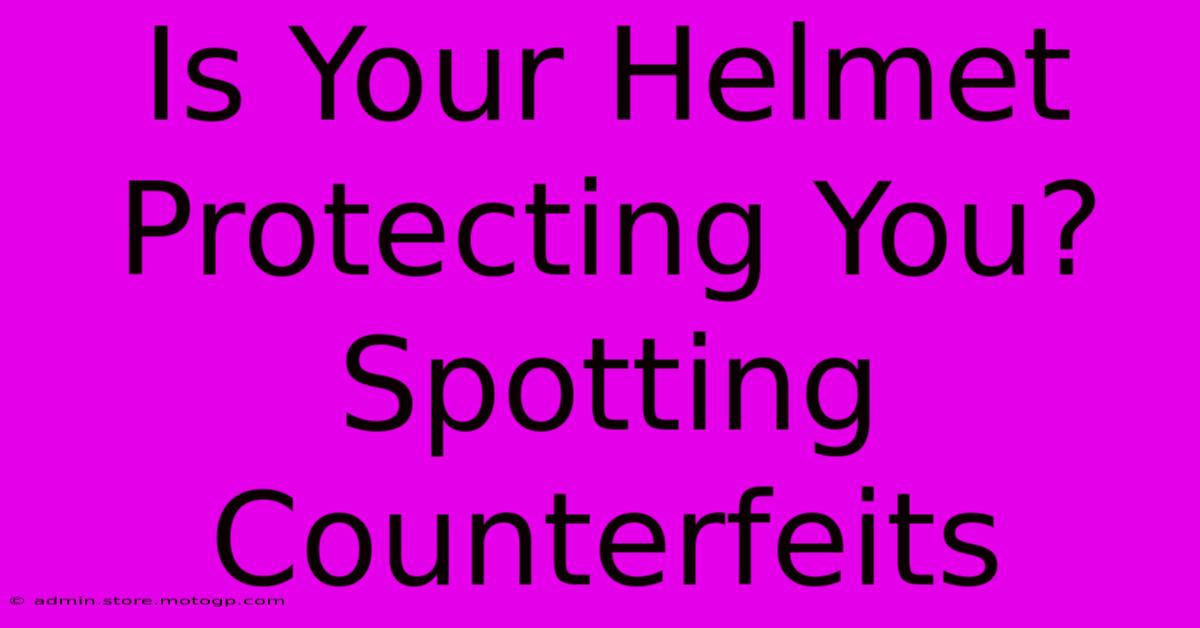Is Your Helmet Protecting You? Spotting Counterfeits

Table of Contents
Is Your Helmet Protecting You? Spotting Counterfeit Helmets
Your helmet is your first line of defense against serious injury. Whether you're a cyclist, motorcyclist, skateboarder, or skier, a helmet's ability to protect you hinges on its authenticity. Sadly, the market is flooded with counterfeit helmets that look the part but drastically compromise your safety. This article will equip you with the knowledge to identify counterfeit helmets and ensure your headgear is genuinely protecting you.
The Dangers of Counterfeit Helmets
Counterfeit helmets are produced without adhering to safety standards. They might use inferior materials, lack proper impact absorption capabilities, or have flawed construction. In a crash, a fake helmet is significantly more likely to:
- Fail to protect your head: The helmet may crack, shatter, or deform inadequately, leaving you vulnerable to severe head trauma.
- Cause secondary injuries: The helmet's components could break off and cause further injury during an impact.
- Offer false sense of security: You believe you're protected, but you're not.
This isn't a matter of saving a few dollars; it's a matter of your safety and well-being.
How to Spot a Counterfeit Helmet
Identifying a counterfeit helmet requires careful observation and comparison. Here's a checklist to help you:
1. Check the Packaging and Labeling:
- Authenticity stickers and holograms: Reputable brands often use security features to verify authenticity. These should be difficult to replicate.
- Clear and legible labeling: Look for clear information about the helmet's model number, safety certifications (like DOT, ECE, CPSC), and manufacturer details. Poor printing or misspelled words are red flags.
- Professional packaging: Counterfeit helmets often arrive in poorly designed or damaged packaging.
2. Examine the Helmet Itself:
- Manufacturing quality: Authentic helmets exhibit a high level of craftsmanship. Look for inconsistencies in the finish, loose parts, or poorly attached straps.
- Safety certifications: Legitimate helmets will clearly display safety certifications. Check for inconsistencies or lack of certification markings.
- Materials and construction: Feel the materials. Cheap plastic and flimsy construction are signs of a counterfeit.
- Strap quality: The straps should be strong, securely fastened, and easily adjustable. Poorly made straps are a significant safety concern.
- Buckle mechanism: The buckle should be robust and easy to use. A flimsy or poorly functioning buckle is a clear warning sign.
3. Research the Manufacturer and Retailer:
- Buy from authorized retailers: Purchase your helmet from reputable sporting goods stores or directly from the manufacturer's website. Avoid suspiciously cheap online marketplaces.
- Verify the manufacturer: Check the manufacturer's website to confirm that the specific model exists and that the retailer is an authorized seller.
- Compare prices: Be wary of deals that seem too good to be true. Substantially lower prices might indicate a counterfeit.
4. Consider Professional Inspection (If Possible)
If you have doubts after checking these points, consider taking the helmet to a professional bike shop or sporting goods store that specializes in safety equipment. They may be able to offer a more definitive assessment of its authenticity.
Protecting Yourself: Beyond Spotting Counterfeits
- Always prioritize safety: Don't compromise on safety for price. A quality helmet is an investment in your health and well-being.
- Regularly inspect your helmet: Check for cracks, damage, or loose parts after every use. Replace your helmet after a significant impact, even if the damage is not immediately visible.
- Keep updated on safety standards: Helmet technology constantly evolves. Stay informed about the latest safety standards and choose a helmet that meets or exceeds these requirements.
Choosing the right helmet and verifying its authenticity is crucial for your safety. Don't gamble with your well-being; take the time to ensure your helmet is genuine and provides the protection you need.

Thank you for visiting our website wich cover about Is Your Helmet Protecting You? Spotting Counterfeits. We hope the information provided has been useful to you. Feel free to contact us if you have any questions or need further assistance. See you next time and dont miss to bookmark.
Featured Posts
-
Racing Motor Bikes For Sale Ride Like A Champion
Feb 18, 2025
-
The Undisputed Champion Whos The Best Motorcyclist
Feb 18, 2025
-
Yamaha V4 Moto Gp Redefining Moto Gp
Feb 18, 2025
-
Moto2 Bike Specs How To Choose The Right Bike For Your Needs
Feb 18, 2025
-
Moto Gp Sprint Race Results Witness The Intensity
Feb 18, 2025
